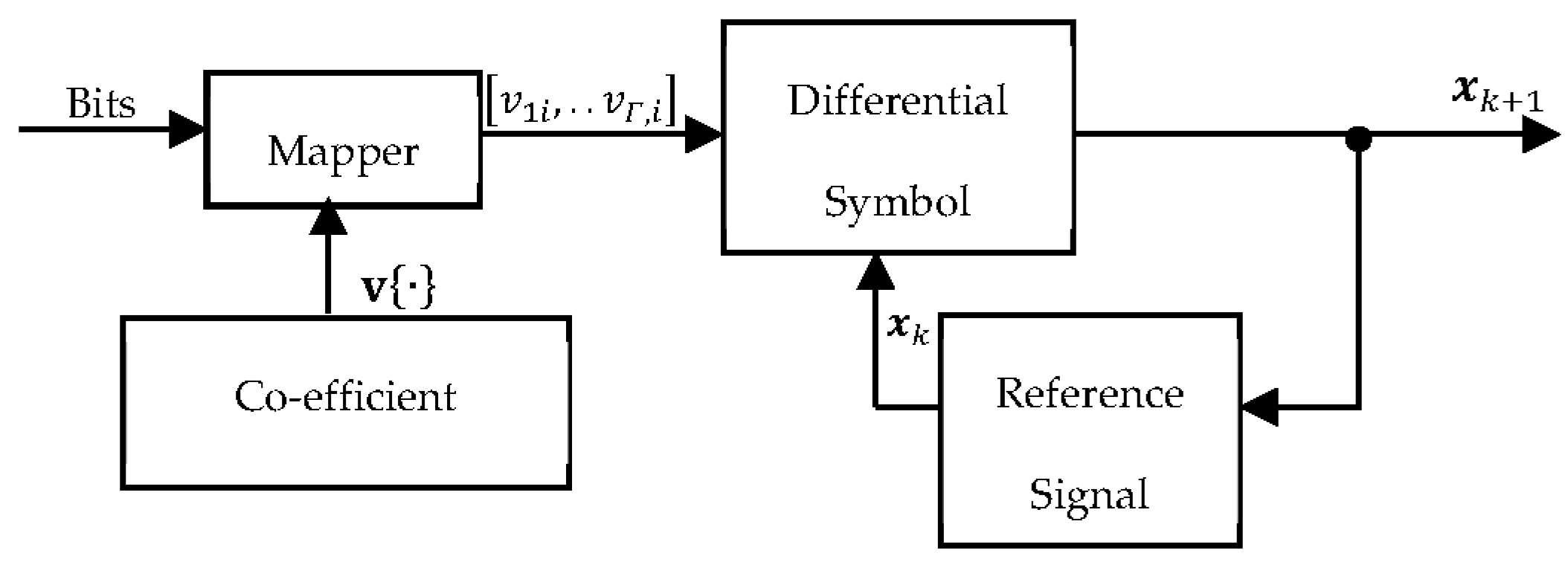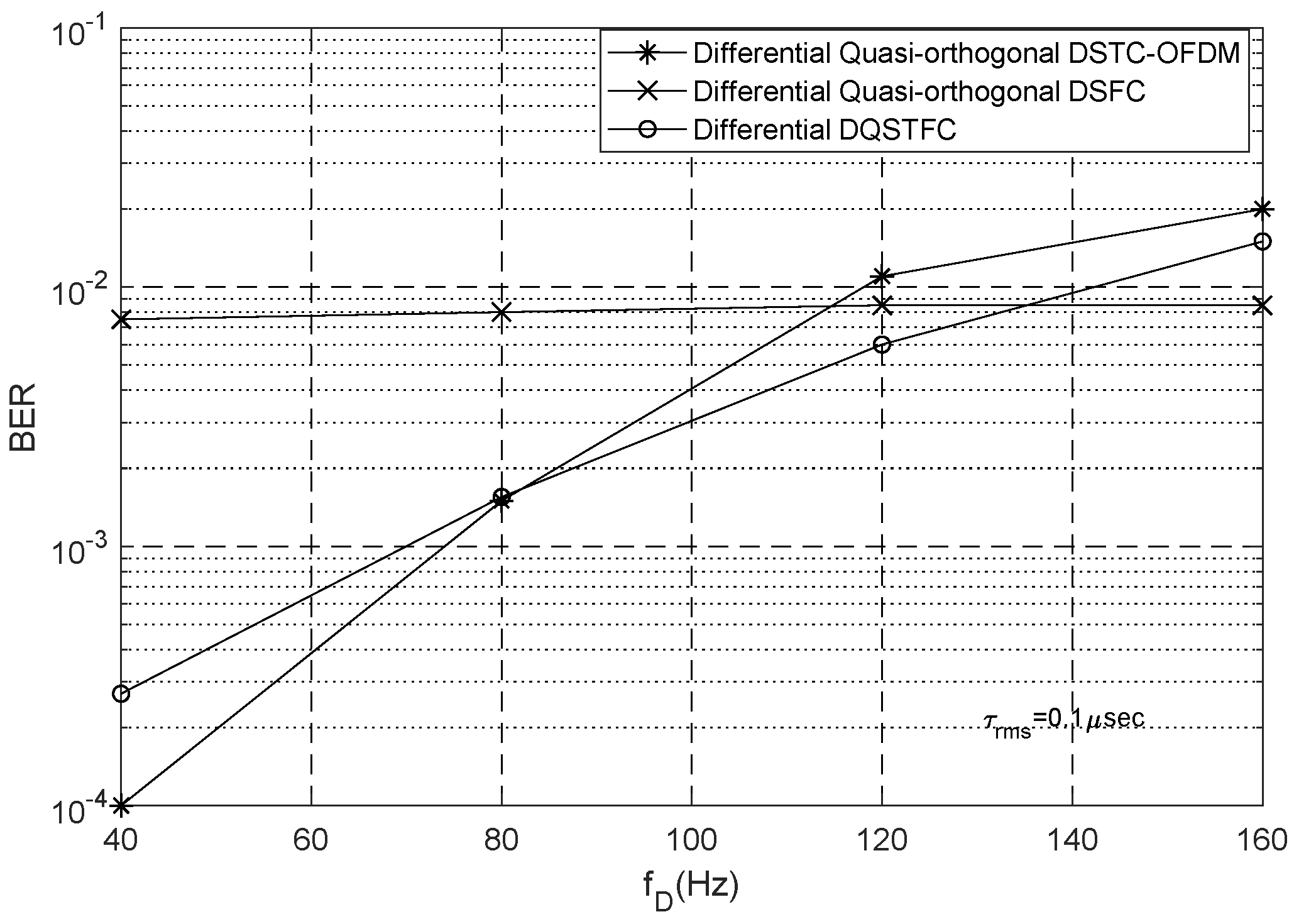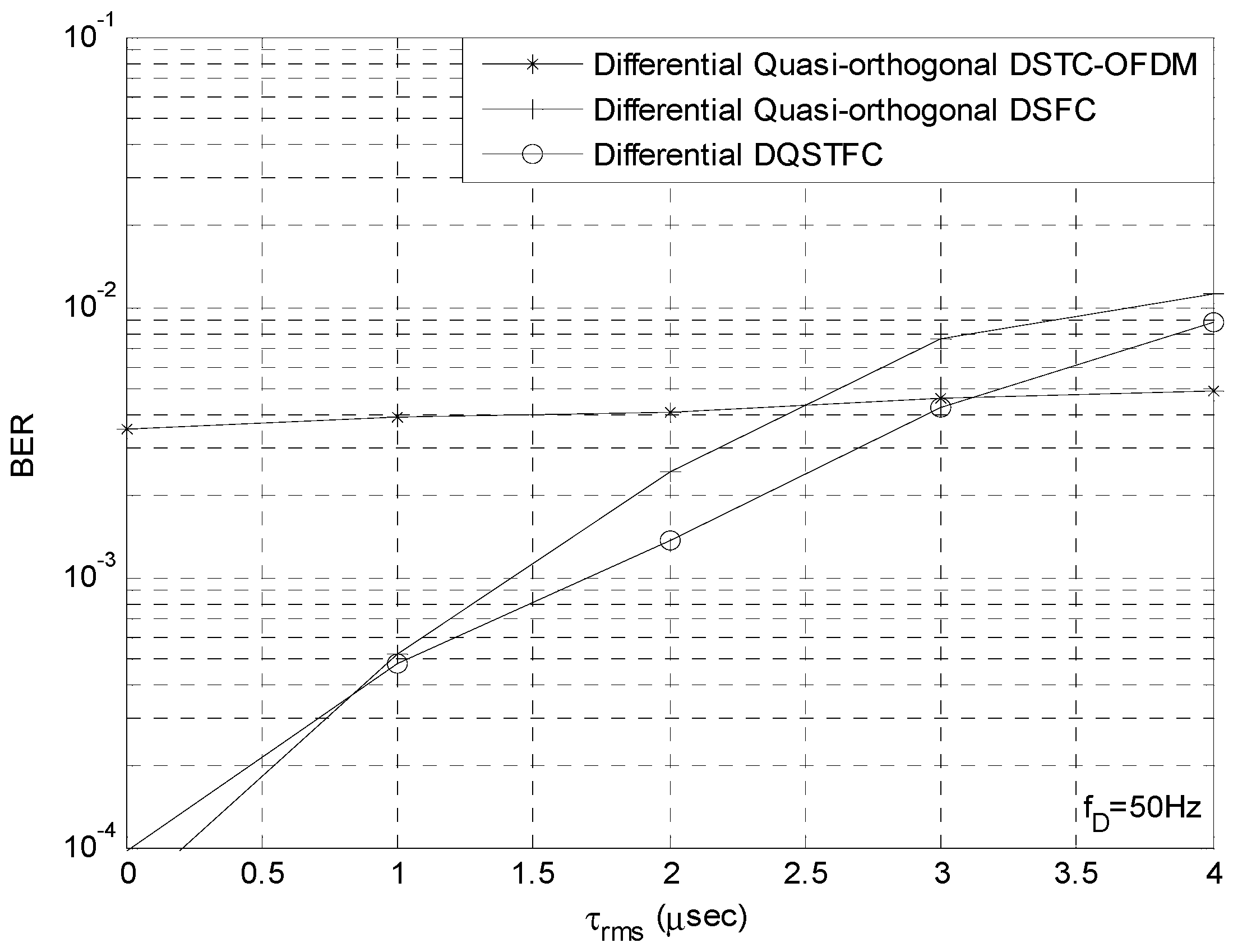Co-Efficient Vector Based Differential Distributed Quasi-Orthogonal Space Time Frequency Coding
Abstract
1. Introduction
- Due to the involvement of multiple broadcast phases in cooperative networks, our proposal of designing the STF codes at the source node aims to simplify the operation of relay nodes. Here, the codewords are carefully distributed in the temporal and frequency dimensions to relax the assumption that the channel is quasi-static in the time and frequency domains for long symbol periods;
- We provide a systematic construction of full rate quasi-orthogonal codes that can exploit full STF diversity and non-coherent signal detection. The full differential procedure using our proposed co-efficient vector design is also provided in this work. Through pair-wise error probability analysis, we derive the necessary conditions for our code to achieve full STF diversity while the coding gain is maximized as much as possible;
- The simulation carried out also provides an analytical study of the performance of our co-efficient vector differential DQSTFC scheme in frequency-selective fading and time-selective fading environments. We also compare and distinguish between the unitary matrices and co-efficient vector designs in terms of Bit Error Rate (BER) performance thus highlighting the robustness of our proposed non-coherent scheme against highly selective fading environments. In addition, we generalize the co-efficient vector design to cooperative networks with four, six, and eight relay nodes.
2. Distributed Space–Time–Frequency Coding
2.1. System Model
2.2. Space Time Frequency Coding at the Source Node
2.3. Multipath Channel Model
2.4. Space Time Frequency Coding at the Relay Nodes
3. Co-Efficient Vector Differential Procedure
3.1. Co-Efficient Vector Generator
3.2. Quasi-Orthogonal Code Construction
3.3. Differential Encoding Using Co-Efficient Vectors
3.4. Differential Decoding Using Co-Efficient Vectors
4. Pairwise Error Probability Analysis
5. Performance Evaluation
6. Conclusions
Future Work
Author Contributions
Funding
Institutional Review Board Statement
Informed Consent Statement
Data Availability Statement
Conflicts of Interest
References
- Avendi, M.R.; Jafarkhani, H. Differential Distributed Space-Time Coding with Imperfect Synchronization in Frequency-Selective Channels. IEEE Trans. Wirel. Commun. 2015, 14, 1811–1822. [Google Scholar] [CrossRef][Green Version]
- Rajan, G.S.; Rajan, B.S. Leveraging coherent distributed space-time codes for noncoherent communication in relay networks via training. IEEE Trans. Wirel. Commun. 2009, 8, 683–688. [Google Scholar] [CrossRef]
- Muhaidat, S.; Ho, P.; Uysal, M. Distributed Differential Space-Time Coding for Broadband Cooperative Networks. In Proceedings of the VTC Spring 2009—IEEE 69th Vehicular Technology Conference, Barcelona, Spain, 26–29 April 2009; IEEE: Piscataway, NI, USA, 2009. [Google Scholar]
- Wang, H.; Xia, X.-G.; Yin, Q. Distributed space-frequency codes for cooperative communication systems with multiple carrier frequency offsets. IEEE Trans. Wirel. Commun. 2009, 8, 1045–1055. [Google Scholar] [CrossRef]
- Wei, Z.; Yabo, L.; Xiang-Gen, X.; Ching, P.C.; Ben Letaief, K. Distributed Space-Frequency Coding for Cooperative Diversity in Broadband Wireless Ad Hoc Networks. IEEE Trans. Wirel. Commun. 2008, 7, 995–1003. [Google Scholar]
- Xu, C.; Rajashekar, R.; Ishikawa, N.; Sugiura, S.; Hanzo, L. Single-RF Index Shift Keying Aided Differential Space–Time Block Coding. IEEE Trans. Signal Process. 2018, 66, 773–788. [Google Scholar] [CrossRef]
- Qu, F.; Wang, Z.; Yang, L. Differential Orthogonal Space-Time Block Coding Modulation for Time-Variant Underwater Acoustic Channels. IEEE J. Ocean. Eng. 2016, 42, 188–198. [Google Scholar] [CrossRef]
- Xiao, L.; Xiao, Y.; Yang, P.; Liu, J.; Li, S.; Xiang, W. Space-Time Block Coded Differential Spatial Modulation. IEEE Trans. Veh. Technol. 2017, 66, 8821–8834. [Google Scholar] [CrossRef]
- Li, J.; Zhang, Z.; Wang, Y.; He, B.; Zheng, W.; Li, M. Deep Learning-Assisted OFDM Channel Estimation and Signal Detection Technology. IEEE Commun. Lett. 2023, 27, 1347–1351. [Google Scholar] [CrossRef]
- Harkat, H.; Monteiro, P.; Gameiro, A.; Guiomar, F.; Farhana Thariq Ahmed, H. A Survey on MIMO-OFDM Systems: Review of Recent Trends. Signals 2022, 3, 359–395. [Google Scholar] [CrossRef]
- Nguyen, H.X.; Tran, N.N.; Nguyen, H.T. Performance analysis of adaptive decode-and-forward relaying in noncoherent cooperative networks. EURASIP J. Wirel. Commun. Netw. 2013, 2013, 281. [Google Scholar] [CrossRef][Green Version]
- Shao, Y.; Wang, L.; Xue, Y. Distributed Alamouti Protocol for Full-Duplex Decode-and-Forward Relaying Networks. IEEE Commun. Lett. 2022, 26, 182–186. [Google Scholar] [CrossRef]
- Wang, F.; Xu, J.; Lau, V.K.N.; Cui, S. Amplify-and-Forward Relaying for Hierarchical Over-the-Air Computation. IEEE Trans. Wirel. Commun. 2022, 21, 10529–10543. [Google Scholar] [CrossRef]
- Simpson, O.; Abdulkadir, Y.; Sun, Y.; Chi, B. Relay-Based Cooperative Spectrum Sensing with Improved Energy Detection in Cognitive Radio. In Proceedings of the 2015 10th International Conference on Broadband and Wireless Computing, Communication and Applications (BWCCA), Krakow, Poland, 4–6 November 2015; pp. 227–231. [Google Scholar]
- Owojaiye, G.; Delestre, F.; Sun, Y. Quasi-Orthogonal Space-Frequency Coding in Non-Coherent Cooperative Broadband Networks. IEEE Trans. Commun. 2014, 62, 1218–1229. [Google Scholar] [CrossRef]
- Kyung Soo, W.; Kyu In, L.; Jong Ho, P.; Kyung Won, P.; Won Young, Y.; Yong Soo, C. A DSFBC-OFDM for a Next Generation Broadcasting System with Multiple Antennas. IEEE Trans. Broadcast. 2007, 53, 539–546. [Google Scholar] [CrossRef]
- Kiran, T.; Rajan, B.S. Partially-coherent distributed space-time codes with differential encoder and decoder. IEEE J. Sel. Areas Commun. 2007, 25, 426–433. [Google Scholar] [CrossRef]
- Abdulkadir, Y.; Simpson, O.; Nwanekezie, N.; Sun, Y. Space-time opportunistic interference alignment in cognitive radio networks. In Proceedings of the 2016 IEEE Wireless Communications and Networking Conference, Doha, Qatar, 3–6 April 2016; pp. 1–6. [Google Scholar]
- Jin, G.; Aubry, A.; De Maio, A.; Wang, R.; Wang, W. Quasi-Orthogonal Waveforms for Ambiguity Suppression in Spaceborne Quad-Pol SAR. IEEE Trans. Geosci. Remote Sens. 2022, 60, 5204617. [Google Scholar] [CrossRef]
- Xiao, L.; Chen, D.; Hemadeh, I.; Xiao, P.; Jiang, T. Generalized Space Time Block Coded Spatial Modulation for Open-Loop Massive MIMO Downlink Communication Systems. IEEE Trans. Commun. 2020, 68, 6858–6871. [Google Scholar] [CrossRef]
- Sanchis Borras, C.; Molina-Garcia-Pardo, J.-M.; Rubio, L.; Pascual-Garcia, J.; Penarrocha, V.M.R.; Llacer, L.J.; Reig, J. Millimeter Wave MISO-OFDM Transmissions in an Intra-Wagon Environment. IEEE Trans. Intell. Transp. Syst. 2021, 22, 4899–4908. [Google Scholar] [CrossRef]
- Niu, Z.; Xiao, L.; Ma, W.; Peng, M.; Jiang, T. Generalized Space-Time Architecture for Ambient Backscatter Communication. IEEE Trans. Commun. 2023, 71, 1912–1925. [Google Scholar] [CrossRef]
- Slaney, A.; Sun, Y. Space-time coding for wireless communications: An overview. IEEE Proc. Commun. 2006, 153, 509. [Google Scholar] [CrossRef][Green Version]
- Owojaiye, G. Design and Performance Analysis of Distributed Space Time Coding Schemes for Cooperative Wireless Networks. Ph.D. Thesis, University of Hertfordshire, Hatfield, UK, 2012. [Google Scholar]
- Abdulkadir, Y.; Simpson, O.; Nwanekezie, N.; Sun, Y. A differential space-time coding scheme for cooperative spectrum sensing in cognitive radio networks. In Proceedings of the 2015 IEEE 26th Annual International Symposium on Personal, Indoor, and Mobile Radio Communications (PIMRC), Hong Kong, China, 30 August–2 September 2015; pp. 1386–1391. [Google Scholar]
- Amor, S.B.; Affes, S.; Bellili, F.; Vilaipornsawai, U.; Zhang, L.; Zhu, P. Multi-Node ML Time and Frequency Synchronization for Distributed MIMO-Relay Beamforming over Time-Varying Flat-Fading Channels. IEEE Trans. Commun. 2019, 67, 2702–2715. [Google Scholar] [CrossRef]
- Jing, Y.; Jafarkhani, H. Using Orthogonal and Quasi-Orthogonal Designs in Wireless Relay Networks. IEEE Trans. Inf. Theory 2007, 53, 4106–4118. [Google Scholar] [CrossRef]
- Jafarkhani, H. Space-Time Coding; Cambridge University Press: Cambridge, UK, 2005. [Google Scholar]
- Jing, Y.; Jafarkhani, H. Distributed differential space-time coding for wireless relay networks. IEEE Trans. Commun. 2008, 56, 1092–1100. [Google Scholar] [CrossRef]
- Susinder Rajan, G.; Sundar Rajan, B. Algebraic distributed differential space-time codes with low decoding complexity. IEEE Trans. Wirel. Commun. 2008, 7, 3962–3971. [Google Scholar] [CrossRef]
- Weifeng, S.; Safar, Z.; Liu, K.J.R. Towards maximum achievable diversity in space, time, and frequency: Performance analysis and code design. IEEE Trans. Wirel. Commun. 2005, 4, 1847–1857. [Google Scholar] [CrossRef]
- Bhatia, R. Positive Definite Matrices; Princeton University Press: Princeton, NJ, USA, 2009. [Google Scholar]
- Qian, M.; Tepedelenlioglu, C.; Zhiqiang, L. Differential space-time-frequency coded OFDM with maximum multipath diversity. IEEE Trans. Wirel. Commun. 2005, 4, 2232–2243. [Google Scholar] [CrossRef]
- Simpson, O.; Sun, Y. Robust Statistics Evidence Based Secure Cooperative Spectrum Sensing for Cognitive Radio Networks. In Proceedings of the 2020 International Wireless Communications and Mobile Computing (IWCMC), Limassol, Cyprus, 15–19 June 2020; pp. 1733–1739. [Google Scholar]
- Abdulkadir, Y.; Simpson, O.; Sun, Y. Interference Alignment for Cognitive Radio Communications and Networks: A Survey. J. Sens. Actuator Netw. 2019, 8, 50. [Google Scholar] [CrossRef]
- Simpson, O.; Sun, Y. Efficient evidence-based decision fusion scheme for cooperative spectrum sensing in cognitive radio networks. Trans. Emerg. Telecommun. Technol. 2020, 31, e3901. [Google Scholar] [CrossRef]
- Ayanoglu, E.; Larsson, E.G.; Karipidis, E. Computational Complexity of Decoding Orthogonal Space-Time Block Codes. IEEE Trans. Commun. 2011, 59, 936–941. [Google Scholar] [CrossRef]
- Wang, X.; Mow, W.H. Decoding and Convergence Analysis for Distributed Low Density Lattice Codes. In Proceedings of the 2021 17th International Symposium on Wireless Communication Systems (ISWCS), Berlin, Germany, 6–9 September 2021; pp. 1–6. [Google Scholar]
- Shlezinger, N.; Alexandropoulos, G.C.; Imani, M.F.; Eldar, Y.C.; Smith, D.R. Dynamic Metasurface Antennas for 6G Extreme Massive MIMO Communications. IEEE Wirel. Commun. 2021, 28, 106–113. [Google Scholar] [CrossRef]
- Nwufo, C.; Sun, Y.; Simpson, O.; Cao, P. Secrecy Energy Efficiency Maximization in Multi-RIS-Aided SWIPT Wireless Network. In Proceedings of the 2023 IEEE 97th Vehicular Technology Conference (VTC2023-Spring), Florence, Italy, 20–23 June 2023; IEEE: Piscataway, NI, USA, 2023. [Google Scholar]
- Tsiftsis, T.A.; Valagiannopoulos, C.; Liu, H.; Boulogeorgos, A.-A.A.; Miridakis, N.I. Metasurface-Coated Devices: A New Paradigm for Energy-Efficient and Secure 6G Communications. IEEE Veh. Technol. Mag. 2022, 17, 27–36. [Google Scholar] [CrossRef]





Disclaimer/Publisher’s Note: The statements, opinions and data contained in all publications are solely those of the individual author(s) and contributor(s) and not of MDPI and/or the editor(s). MDPI and/or the editor(s) disclaim responsibility for any injury to people or property resulting from any ideas, methods, instructions or products referred to in the content. |
© 2023 by the authors. Licensee MDPI, Basel, Switzerland. This article is an open access article distributed under the terms and conditions of the Creative Commons Attribution (CC BY) license (https://creativecommons.org/licenses/by/4.0/).
Share and Cite
Nwanekezie, N.; Simpson, O.; Owojaiye, G.; Sun, Y. Co-Efficient Vector Based Differential Distributed Quasi-Orthogonal Space Time Frequency Coding. Sensors 2023, 23, 7540. https://doi.org/10.3390/s23177540
Nwanekezie N, Simpson O, Owojaiye G, Sun Y. Co-Efficient Vector Based Differential Distributed Quasi-Orthogonal Space Time Frequency Coding. Sensors. 2023; 23(17):7540. https://doi.org/10.3390/s23177540
Chicago/Turabian StyleNwanekezie, Nnamdi, Oluyomi Simpson, Gbenga Owojaiye, and Yichuang Sun. 2023. "Co-Efficient Vector Based Differential Distributed Quasi-Orthogonal Space Time Frequency Coding" Sensors 23, no. 17: 7540. https://doi.org/10.3390/s23177540
APA StyleNwanekezie, N., Simpson, O., Owojaiye, G., & Sun, Y. (2023). Co-Efficient Vector Based Differential Distributed Quasi-Orthogonal Space Time Frequency Coding. Sensors, 23(17), 7540. https://doi.org/10.3390/s23177540






